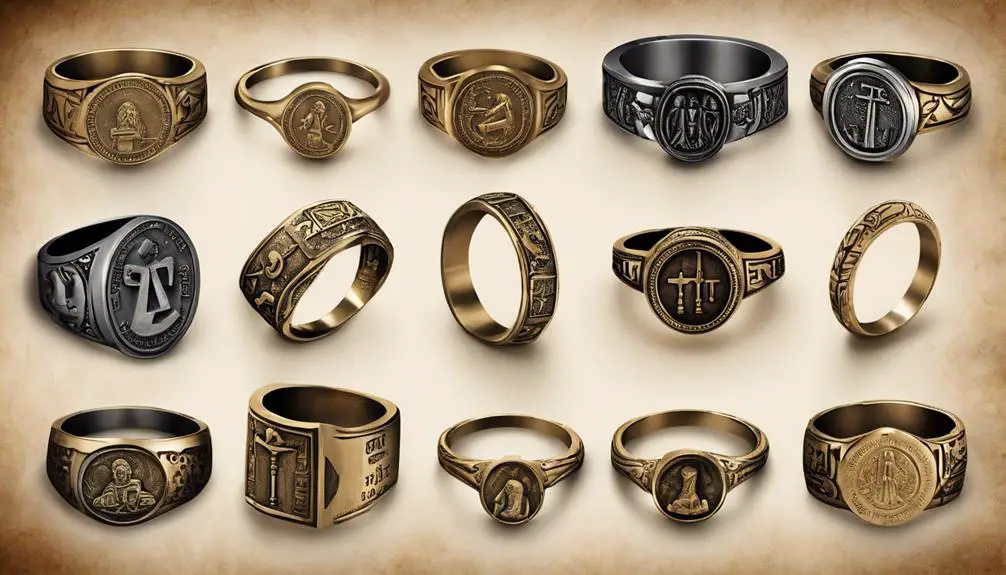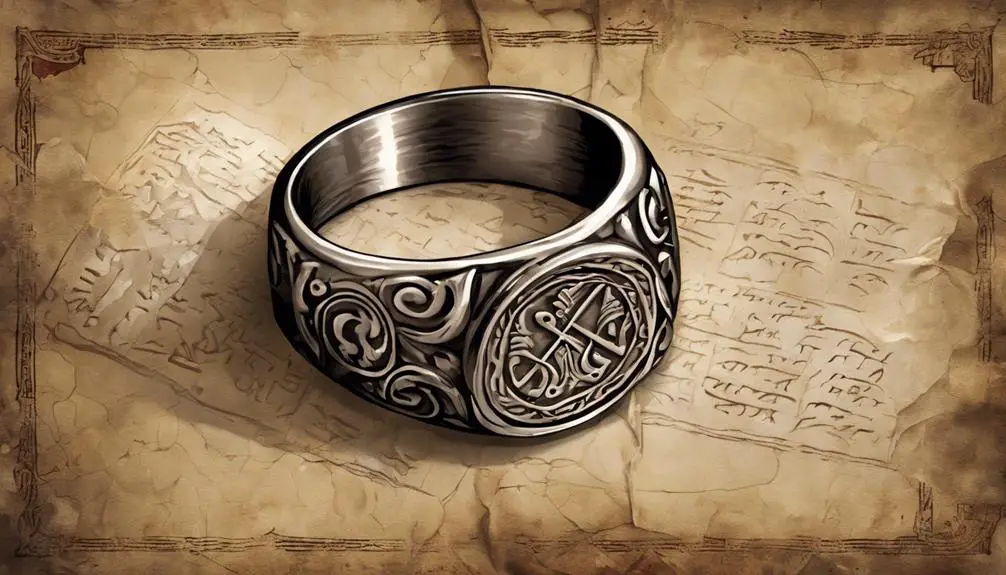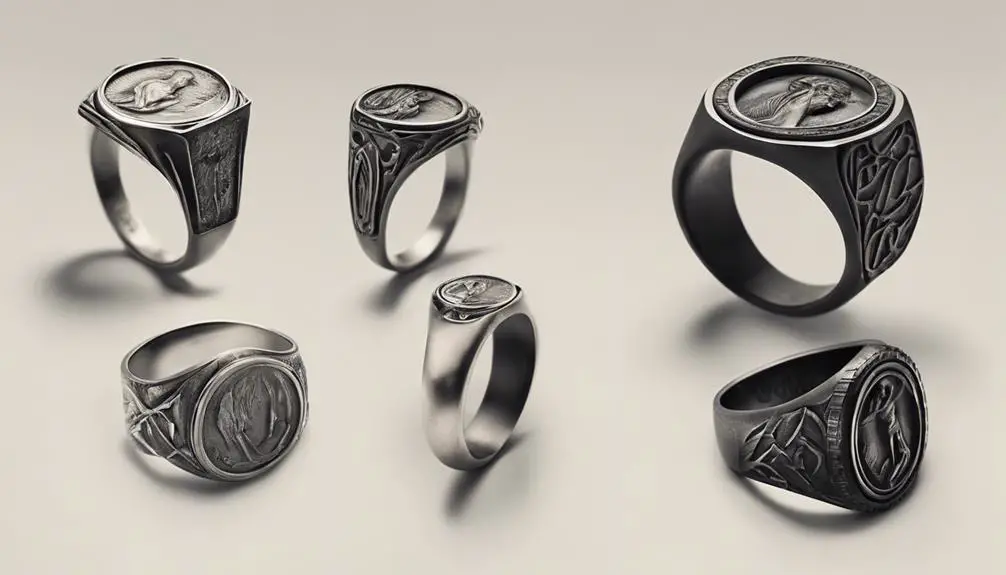The signet ring in the Bible unlocks mysteries of power, identity, and divine will, beckoning us to delve deeper into its sacred narrative.

Signet Ring in the Bible
Diving into the biblical narrative is akin to unearthing a treasure trove, with the signet ring shimmering as a gem of historical and symbolic significance. You'll find that these rings weren't just fashion statements; they wielded the power to seal destinies and enact decrees. From the gripping tale of Joseph's ascent in Egypt to the dramatic reversal of fate in the Book of Esther, signet rings play a pivotal role.
Yet, there's more beneath the surface of these stories, touching on prophetic meanings and cultural rituals that resonate even today. Let's explore how this ancient symbol's legacy shapes our understanding of authority, identity, and divine providence.
Key Takeaways
- Signet rings in the Bible symbolize divine authority and covenant promises.
- Notable biblical figures used signet rings for authentication and authority.
- They represent personal identity and God's unbreakable promises to believers.
- Biblical signet rings prefigure the believers' inheritance in God's kingdom.
Historical Roots of Signet Rings

Signet rings, historically revered symbols of authority and identity, have their origins deeply rooted in ancient civilizations, where they were used to authenticate documents and signify power. These rings weren't merely ornamental; they were imbued with the essence of their owner's influence and command. Delving into the craftsmanship of these artifacts reveals a blend of manufacturing techniques and material diversity that underscores their significance across cultures.
You'll find that the art of crafting signet rings was meticulously honed over centuries. Artisans employed various methods, including engraving and casting, to create intricate designs on durable materials. This ensured that each imprint left by a signet ring was as unique as its wearer's signature. Material diversity played a crucial role in distinguishing the ranks and roles within societies. While royalty and the elite might flaunt signet rings made of precious metals and gemstones, those of lesser stature utilized materials that were more readily available yet still resilient, such as bronze or iron.
This careful marriage of manufacturing techniques and material diversity not only facilitated the practical function of signet rings in ancient times but also elevated them to objects of profound theological and historical significance.
Symbolism and Authority

Beyond their intricate craftsmanship and material diversity, signet rings also embodied a profound symbolism of authority and divine right, serving as tangible markers of power and legitimacy within ancient societies. These rings weren't merely ornamental; they were essential tools for governance and communication, deeply intertwined with the societal structures of their time.
Here's how signet rings served as symbols of authority:
- Personal identification: They functioned as ancient forms of ID, uniquely associating the wearer with their status and rights. This personal link between the ring and its owner underscored the individual's authority within their community.
- Authentication of documents: Signet rings were used to seal letters and decrees, ensuring the document's authenticity. Only the ring's impression could validate the sender's identity, making it a powerful tool in governance.
- Artistic expression: The designs on these rings often conveyed the owner's lineage, beliefs, or divine favor, reinforcing their right to rule. This blend of art and authority emphasized the ruler's uniqueness and legitimacy.
- Transfer of power: Passing on a signet ring could symbolize the transfer of authority, making it a physical manifestation of one's right to lead or govern.
These aspects highlight the multifaceted role of signet rings as symbols of authority, blending personal identification with artistic expression to affirm and communicate power.
Notable Biblical Instances

Delving into the biblical narrative, we find that signet rings played pivotal roles in several key episodes, underscoring their importance in ancient Hebraic culture and theology. These rings weren't merely ornamental; they bore unique ring designs that signified authority, identity, and covenant.
For instance, the story of Judah and Tamar showcases a dramatic ownership dispute rooted in the recognition of a signet ring, which ultimately led to the acknowledgment of paternity and rights.
Moreover, in the narrative of Joseph in Egypt, Pharaoh's act of giving his signet ring to Joseph symbolized the transfer of power and trust, marking Joseph as a man of authority in a foreign land. This act wasn't just a transfer of a physical object but a profound gesture of entrusting the economy and governance into Joseph's hands, highlighting the ring's significance in conferring authority.
These instances illustrate how signet rings weren't just personal adornments but pivotal in disputes, agreements, and the transmission of power. They were emblematic of one's status and were often at the center of significant theological and historical moments, reflecting their deep-rooted significance in the tapestry of biblical lore.
The Prophetic Significance

In examining biblical texts, it's clear that signet rings held not only practical but also profound prophetic significance, serving as symbols of divine promises and eschatological revelations. These objects, often overlooked, carry rich, layered meanings, transcending their material value to embody spiritual truths and divine assurances. Let's delve deeper:
- Divine Authentication: Signet rings in biblical narratives often symbolize God's authority and authentication of His messengers' roles and missions. They're like divine seals, marking individuals or messages with God's approval and authority.
- Covenant Promises: These rings serve as tangible reminders of God's unbreakable promises to His people. Just as a signet ring is unique to its owner, so are God's covenants personalized and enduring.
- Authority and Governance: In prophecy, they often prefigure the transfer or establishment of divine authority on earth, hinting at the coming of God's kingdom and the ultimate governance of the righteous.
- Spiritual Inheritance: Signet rings symbolize the believers' inheritance in God's kingdom, representing not just material wealth but a spiritual legacy that's imperishable, undefiled, and unfading.
Through these symbols, the biblical narrative weaves together the temporal with the eternal, offering insights into both immediate contexts and the unfolding of divine history.
Cultural and Ritual Uses

Throughout history, signet rings have played pivotal roles in various cultures and religious rituals, often symbolizing authority, identity, and divine protection. These rings weren't merely ornamental; they were imbued with significant cultural and theological meaning. The material choices for these rings—often gold, silver, or precious stones—weren't arbitrary. Each element held symbolic significance, reflecting the wearer's status and divine favor. Gold, for instance, symbolized purity and was thought to reflect the glory of the divine, making it a preferred material for priests and kings.
Crafting techniques, too, were steeped in ritual significance. The intricate designs often featured sacred symbols or inscriptions, believed to offer protection to the wearer or to seal their authority in the physical and spiritual realms. These techniques weren't just about aesthetics; they were acts of devotion, each step imbued with prayer and purpose.
In this way, signet rings served as tangible connections between the divine and the earthly, embodying prayers, authority, and identity. They were more than mere tools for sealing documents; they were potent symbols of covenant and divine protection, integral to the cultural and ritual fabric of their time.
Modern Interpretations and Legacy

You'll find that the legacy of signet rings has evolved, now embodying a rich tapestry of modern interpretations alongside their historical and theological significance. This transformation reflects a blend of past traditions and contemporary values, where fashion trends and personal customization play pivotal roles.
The signet ring's journey from biblical times to today can be understood through several key developments:
- Fashion Trends: Once a symbol of authority and identity, signet rings have become fashionable accessories. Designers often draw inspiration from their storied past to create pieces that resonate with today's aesthetics while paying homage to their rich history.
- Personal Customization: In the spirit of their original purpose, modern signet rings often feature personalized engravings. However, today's preferences lean towards initials, family crests, or symbolically significant motifs, rather than official seals.
- Symbolic Gifts: Reflecting their historical significance as tokens of trust and power, signet rings are now popular as gifts that symbolize a deep personal connection or family heritage, embodying both affection and tradition.
- Cultural Revival: Interest in historical and theological studies has spurred a cultural revival of signet rings, with enthusiasts seeking designs that echo the biblical era, thus maintaining a link to their ancestral and spiritual roots.
Frequently Asked Questions
How Were Signet Rings Crafted and What Materials Were Typically Used in Biblical Times?
You're diving into how signet rings were crafted and the materials typically used back in biblical times.
Delving into crafting techniques, you'll find that artisans often carved these rings from hard materials like stone, metal, or even wood, using tools that etched intricate designs.
Material sources varied, with precious metals and gems being highly prized for their durability and beauty.
This exploration not only reflects historical craftsmanship but also carries a theological significance, highlighting identity and authority.
Were Signet Rings Exclusive to Men, or Did Women in the Bible Also Have and Use Them?
In a nutshell, you're diving into the intriguing realm of gender roles and jewelry etiquette.
Historically, signet rings weren't just a man's affair. Women in biblical times also had and utilized them, challenging the traditional gender norms. This practice wasn't just about adornment; it was deeply rooted in societal status and identity.
Theologically, it reflects a nuanced understanding of equality and individuality, painting a broader picture of social dynamics in ancient times.
How Did the Design and Inscriptions on Biblical Signet Rings Vary Across Different Cultures Mentioned in the Bible?
You're exploring how the design and inscriptions on signet rings varied across cultures. These rings, steeped in cultural significance, displayed a wide array of artistic styles, reflecting the diverse societies mentioned.
Whether used for official decrees or personal identification, each ring's unique characteristics, from intricate inscriptions to symbolic designs, offered insights into the theological and historical contexts of their times, showcasing the rich tapestry of beliefs and traditions intertwined within these ancient communities.
Can Any Specific Biblical Events Be Directly Attributed to the Use or Exchange of Signet Rings?
Certainly, specific events were influenced by the exchange or use of rings, symbolizing authority and trust. For instance, rings acted as diplomatic gifts, cementing alliances or signaling favor. Analytically speaking, these instances weren't just about the physical transfer but also the trust and power they represented.
Historically and theologically, such exchanges underscored the deep significance of ring symbolism, intertwining with the narrative fabric of the time, marking pivotal moments of decision and transition.
How Did the Loss or Theft of a Signet Ring Impact Its Owner's Status or Authority in Biblical Narratives?
Imagine losing your entire identity with the slip of a ring from your finger. In the narratives you're exploring, the loss or theft of a signet ring wasn't just an inconvenience; it was a crisis.
This tiny object symbolized authority and identity, making its disappearance a catalyst for ownership disputes and a dramatic shift in power dynamics.
Analyzing these stories, you uncover the profound impact of ring symbolism on an individual's status and authority.
Conclusion
You've journeyed through the historical depth of signet rings, uncovering their symbolism and authority within the Bible. Notable instances revealed their significant roles, while the prophetic significance added layers of theological depth.
Cultural and ritual uses further illustrated their multifaceted roles across time. In modern interpretations, the legacy of signet rings continues to evolve, symbolizing the enduring power of faith and identity.
This exploration underscores the intricate tapestry of history, theology, and culture woven into the biblical narrative of signet rings.



Sign up